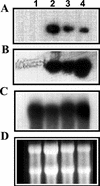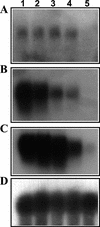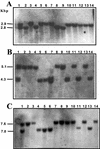Differentially regulated, vegetative-mycelium-specific hydrophobins of the edible basidiomycete Pleurotus ostreatus
- PMID: 12147487
- PMCID: PMC124019
- DOI: 10.1128/AEM.68.8.3891-3898.2002
Differentially regulated, vegetative-mycelium-specific hydrophobins of the edible basidiomycete Pleurotus ostreatus
Abstract
Three different hydrophobins (Vmh1, Vmh2, and Vmh3) were isolated from monokaryotic and dikaryotic vegetative cultures of the edible fungus Pleurotus ostreatus. Their corresponding genes have a number of introns different from those of other P. ostreatus hydrophobins previously described. Two genes (vmh1 and vmh2) were expressed only at the vegetative stage, whereas vmh3 expression was also found in the fruit bodies. Furthermore, the expression of the three hydrophobins varied significantly with culture time and nutritional conditions. The three genes were mapped in the genomic linkage map of P. ostreatus, and evidence is presented for the allelic nature of vmh2 and POH3 and for the different locations of the genes coding for the glycosylated hydrophobins Vmh3 and POH2. The glycosylated nature of Vmh3 and its expression during vegetative growth and in fruit bodies suggest that it should play a role in development similar to that proposed for SC3 in Schizophyllum commune.
Figures







Similar articles
-
Identification of three differentially expressed hydrophobins in Pleurotus ostreatus (oyster mushroom).Microbiology (Reading). 1998 Nov;144 ( Pt 11):2961-2969. doi: 10.1099/00221287-144-11-2961. Microbiology (Reading). 1998. PMID: 9846731
-
Identification of hydrophobin genes and their physiological functions related to growth and development in Pleurotus ostreatus.Microbiol Res. 2021 Jun;247:126723. doi: 10.1016/j.micres.2021.126723. Epub 2021 Feb 14. Microbiol Res. 2021. PMID: 33636611
-
Physiological function of hydrophobin Hydph16 in cell wall formation in agaricomycete Pleurotus ostreatus.Fungal Genet Biol. 2025 Feb;176:103943. doi: 10.1016/j.fgb.2024.103943. Epub 2024 Nov 28. Fungal Genet Biol. 2025. PMID: 39612978
-
Features of disruption mutants of genes encoding for hydrophobin Vmh2 and Vmh3 in mycelial formation and resistance to environmental stress in Pleurotus ostreatus.FEMS Microbiol Lett. 2023 Jan 17;370:fnad036. doi: 10.1093/femsle/fnad036. FEMS Microbiol Lett. 2023. PMID: 37081785
-
Genetic linkage map and expression analysis of genes expressed in the lamellae of the edible basidiomycete Pleurotus ostreatus.Fungal Genet Biol. 2006 May;43(5):376-87. doi: 10.1016/j.fgb.2006.01.008. Epub 2006 Mar 13. Fungal Genet Biol. 2006. PMID: 16531085
Cited by
-
A review of the role of biosurfactants in the biodegradation of hydrophobic organopollutants: production, mode of action, biosynthesis and applications.World J Microbiol Biotechnol. 2022 Sep 3;38(11):216. doi: 10.1007/s11274-022-03401-6. World J Microbiol Biotechnol. 2022. PMID: 36056983 Review.
-
Identification of Key Regulatory Pathways of Basidiocarp Formation in Pleurotus spp. Using Modeling, Simulation and System Biology Studies.J Fungi (Basel). 2022 Oct 13;8(10):1073. doi: 10.3390/jof8101073. J Fungi (Basel). 2022. PMID: 36294638 Free PMC article.
-
De Novo Sequencing and Transcriptome Analysis of Pleurotus eryngii subsp. tuoliensis (Bailinggu) Mycelia in Response to Cold Stimulation.Molecules. 2016 May 17;21(5):560. doi: 10.3390/molecules21050560. Molecules. 2016. PMID: 27196889 Free PMC article.
-
Comparative transcriptional analyses of Pleurotus ostreatus mutants on beech wood and rice straw shed light on substrate-biased gene regulation.Appl Microbiol Biotechnol. 2021 Feb;105(3):1175-1190. doi: 10.1007/s00253-020-11087-9. Epub 2021 Jan 7. Appl Microbiol Biotechnol. 2021. PMID: 33415371
-
Pleurotus ostreatus as a model mushroom in genetics, cell biology, and material sciences.Appl Microbiol Biotechnol. 2024 Feb 19;108(1):217. doi: 10.1007/s00253-024-13034-4. Appl Microbiol Biotechnol. 2024. PMID: 38372792 Free PMC article. Review.
References
-
- Abdellah, M. M. F., M. F. Z. Emara, and T. F. Mohammady. 2000. Open field interplanting of oyster mushroom with cabbage and its effect on the subsequent eggplant crop. Ann. Hortic. Sci. Cairo 45:281-293.
-
- Ando, A., A. Harada, K. Miura, and Y. Tamai. 2001. A gene encoding a hydrophobin, fvh1, is specifically expressed after the induction of fruiting in the edible mushroom Flammulina velutipes. Curr. Genet. 39:190-197. - PubMed
-
- Asgeirsdóttir, S. A. 1994. Proteins involved in emergent growth of Schizophyllum commune. Ph.D. thesis. University of Groningen, Groningen, The Netherlands.
-
- Asgeirsdóttir, S. A., O. M. de Vries, and J. G. Wessels. 1998. Identification of three differentially expressed hydrophobins in Pleurotus ostreatus (oyster mushroom). Microbiology 144:2961-2969. - PubMed
-
- Asgeirsdóttir, S. A., J. R. Halsall, and L. A. Casselton. 1997. Expression of two closely linked hydrophobin genes of Coprinus cinereus is monokaryon-specific and down-regulated by the oid-1 mutation. Fungal Genet. Biol. 22:54-63. - PubMed
Publication types
MeSH terms
Substances
Associated data
- Actions
- Actions
- Actions
- Actions
- Actions
- Actions
LinkOut - more resources
Full Text Sources

